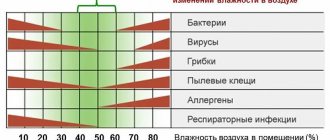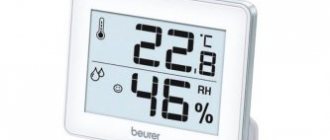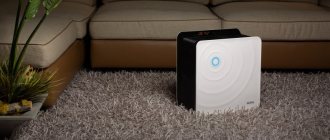Humidity standards in residential premises
The World Health Organization recommends maintaining humidity in a living space at 30-60 percent, the optimal value being 45. There are also standards according to GOST, which have slightly different values: according to the document, in winter the optimal value is 30-45 percent, in summer - 30-45 percent. 65. However, WHO recommendations need to be taken more carefully, because GOST standards are aimed primarily at engineers and builders, and not at the residents themselves.
Why are humidity standards not a specific indicator, but a range of values? The fact is that it can fluctuate depending on several factors: the type of room (the air in the bathroom is humid, the air in the bedroom is drier) or the time of year (the humidity in the apartment is higher in spring and summer, lower in winter). Deviations from this norm are fraught with problems with the skin and mucous membranes (throat, eyes, nose), premature aging, various allergies and respiratory infections. The main risk groups are children, allergy sufferers and the elderly.
Legislative regulation of the issue
Regulation of ventilation and humidity standards in office premises is regulated at the legislative level by the following documents:
- Labor Code of the Russian Federation.
- SanPiN 2.2.4.548-96, which specifies the requirements for organizing the microclimate in production premises.
- SanPiN 2.2.4.3359-16, which includes sanitary requirements for physical factors in office premises.
- Standards and rules SanPiN 2.2.2/2.4.1340-03.
- SNiP 2.09.04-87, which lists the rules and recommendations for administrative and domestic buildings.
- SP336.1325800.2017 “Ventilation and air conditioning systems. Rules of operation."
There are situations that are not regulated by sanitary standards. This includes a faulty office toilet. According to Art. 157 of the Labor Code of the Russian Federation, the employee has every right not to start work in this case while maintaining 2/3 of his average salary.
Normal air humidity in an apartment for a child
Every day, a child’s body encounters a huge number of bacteria and viruses; it is no coincidence that it is in childhood that we get sick most often. Children have weak immunity, they are just learning to fight unfamiliar microorganisms, so you need to carefully monitor the air quality in the children's room, especially the level of moisture.
Pediatricians recommend maintaining the humidity in the baby's room at 60-70 percent, regardless of the time of year. If it is not high enough, the mucous membranes of the nose and throat dry out and lose their protective abilities, skin redness, itching, and peeling appear. Dry air makes it difficult for oxygen to enter the body, which is why the baby may feel unwell: complain of weakness and dizziness. In addition, the child becomes irritable and tired, and has problems concentrating.
Due to too humid air, condensation appears on the windows, and a favorable environment is formed for the growth of fungus, mold and pathogens. Microorganisms, in turn, can cause various respiratory infections.
What should employees do in case of violations?
If any violations are detected, the employee is obliged to notify his supervisor in writing. If there is no response and no positive changes are expected, you must write a statement to the labor inspectorate or Rospotrebnadzor.
The application must include:
- Full name and position of the applicant.
- The essence of the problem. It should be clear and concisely presented, without carrying unnecessary information.
- Date and signature.
We do not recommend completing the documents yourself. Save time - contact our lawyers by phone:
8 (800) 302-76-94Moscow
The manager of an enterprise needs to pay great attention to the design and proper operation of ventilation systems in office premises. Compliance with all standards not only increases the safety of employees, but also increases their productivity. Violation of norms entails not only administrative liability, but also suspension of the organization’s activities for an indefinite period.
How to check the air humidity in an apartment
If you notice the symptoms mentioned above in yourself or your family members, it would be logical to assume that the culprit is too humid or, conversely, too dry air. There are several ways to measure humidity levels at home:
1. A glass of water. Not the most accurate, but a proven folk method. You don’t need to go anywhere to do this; you will find everything you need to measure humidity at home. Pour water into a glass and leave it in the refrigerator for three to four hours. Then place the glass away from heaters, preferably in the center of the room, and observe it. Within five minutes, condensation will form on the surface of the glass.
- If after a few minutes the water on the glass has dried, the air humidity in the room is low;
- If water begins to flow down the walls, the humidity is increased;
- If the condensation remains the same, the moisture level is normal.
2. Assmann table. Measure the air temperature in the room with a regular mercury thermometer and write down the result. Then wrap the thermometer head tightly with wet gauze (this will create a “wet” thermometer). After ten minutes, measure and record the temperature again. Subtract the second number from the first number. Using a special table you can determine the air humidity in the room.
3. Fir cone. Place the fir cone away from radiators and heaters and leave it for several hours. If the air in the room is dry, the cone will open; if the air is too humid, the scales will shrink tightly.
4. Hygrometer. The simplest and most accurate method is to purchase a hygrometer (a device for measuring moisture levels). With its help you can easily find out the current humidity in the room. Online stores have a large selection of multifunctional devices that can look like thermometers, small wall or table clocks with a mechanical or electronic display.
In addition, obvious signs of low air humidity can be dried leaves of indoor plants and electrified synthetic clothing.
Employer's liability for violations
Norms and rules for indoor ventilation systems are specified in SP336.1325800.2017 . This summary contains everything:
- basic rules on the use of ventilation systems in buildings with various purposes, room humidity;
- calculation formulas, liability of persons who do not comply with them.
According to the Labor Code of the Russian Federation, the employer is obliged to ensure the safety of employees during the working day. Violation of the rules leads to administrative liability in the form of a fine:
- for officials in the amount of 1,500 rubles;
- for legal entities – from 30 thousand rubles.
Responsibility for such offenses is established by Articles 192-195 of the Labor Code of the Russian Federation, which include disciplinary sanctions, as well as Art. 55 of the Federal Law “On the Sanitary and Epidemiological Welfare of the Population”, adopted on March 30, 1999. The punishment is regulated by the Code of Administrative Offenses, in particular Art. 5.27 and art. 5.27.1.
Consequences of excess humidity. How to reduce humidity to normal
There are many reasons for high humidity in the home. Excess moisture in the air appears if you use low-quality materials for wall decoration, often dry wet things in the room, and do not open windows for ventilation.
High humidity and low air exchange are ideal conditions for the proliferation of fungi, bacteria and other harmful microorganisms. Due to dampness, the immune system weakens and seasonal diseases such as asthma and rheumatism worsen. Fungal spores easily enter the respiratory tract, causing respiratory diseases and allergies.
Excess humidity causes the following diseases:
- Frequent influenza infections, bronchitis, asthma, pulmonary tuberculosis, allergies;
- Systematic headache, migraine;
- Cardiovascular diseases, hypertension, nosebleeds;
- Rheumatism.
A particularly dangerous combination is high humidity plus high air temperature. In this case, the body temperature also rises - the body tries to cool down, and active sweating begins. This works under normal conditions, but with increased humidity, sweat does not work as a “cooler” for the skin, but on the contrary, the body continues to heat up, losing even more moisture and beneficial microelements. Under such conditions, the risk of more severe and dangerous body reactions increases: muscle spasms, convulsions, disorientation and fainting.
In order to stay healthy for as long as possible, you first need to create a healthy microclimate in your home. Here are a few ways to help you get rid of excess moisture:
- Ventilate the room regularly. This will increase air exchange in the room, normalize humidity and temperature.
- Install the hood. Exhaust fans eliminate excess moisture in the bathroom or kitchen and prevent condensation from appearing on the walls and surfaces of the room.
- Buy a climate system (for example, Airnanny A7) or a dehumidifier. Such devices have built-in devices for measuring moisture and monitoring its level.
- Make repairs in a timely manner. Regular inspections, cleaning and replacement of plumbing and plumbing prevent leaks and moisture accumulation in hard-to-reach areas.
- Use heating devices. Batteries and heat emitters warm and dry the air.
Consequences of insufficient humidity. How to increase humidity in your home
An adult's body is 60 percent water, while a newborn's body is, on average, 80 percent. When air humidity drops, the skin begins to dry out and the body begins to dehydrate. It is not surprising that the subsequent symptoms make many people, for the first time in their lives, ask the question “what humidity should be in the apartment?”
The mucous membranes of the respiratory tract lose their protective function, facilitating access for viruses and bacteria. A sore throat and breathing problems may develop. Clear signs of dry air are a constant sore throat and a night cough. The mucous membrane of the eye also loses its protective functions, opening the way for bacterial infection. In addition, dry air prevents the normal supply of oxygen to the body; with a long stay in such an atmosphere, well-being and concentration deteriorate. Also, dry air causes additional irritation for those who wear contact lenses.
- To increase moisture levels in your home, take one of these measures:
- Buy an aquarium or table fountain;
- Use air conditioning and heating devices to a minimum;
- Install a climate system or humidifier;
- Dry clothes on radiators;
- Carry out wet cleaning regularly;
- Get indoor plants (the more, the better);
- Ventilate the room often.
To increase the humidity level in a children's room to 60 percent, you need to do wet cleaning several times a day and spray water with a spray bottle. Place several containers with clean cold water under the radiator - under the influence of heat, the water will evaporate, humidifying the air in the baby’s room.
Air humidity in the apartment at different times of the year
The relative humidity in the apartment varies depending on the time of year. This is due to the fact that at different air temperatures and atmospheric pressure, different amounts of moisture can fit in it (the higher the temperature, the more moisture the air can contain). The air humidity in an apartment in winter indoors drops to 15-30 percent. Due to the low temperature outside, the rooms are ventilated less often. Radiators and additional heating devices dry out the air. At a low level of relative humidity, the intensity of evaporation of liquid from the skin and mucous membrane increases, the protective properties of the body weaken, and the risk of colds increases. Therefore, in winter it is extremely important to maintain the humidity in the house at an optimal level.
The humidity in the apartment rises in the summer and reaches 40-60 percent, and on particularly hot days this figure is much higher. If the level of air humidity exceeds the permissible value, this leads to an increase in body temperature, weakness, increased heart rate and breathing, and a violation of heat exchange occurs.
How to prevent violations?
To prevent violations, you need to adhere to the rules and regulations and comply with the relevant requirements when calculating indicators .
The ventilation system is divided into natural and artificial.
- With natural ventilation, air exchange occurs due to temperature differences, as well as wind force. This type of ventilation depends on what the walls of the room are made of. Good ventilation is provided by walls made of concrete and wood. They allow air to pass through perfectly, so you need to take this detail into account.
- Artificial ventilation is carried out using additional ventilation devices. And for high-quality work, you need to adhere to the installation standards that are mentioned above in the article.
How to maintain normal humidity in the house
Many people think that air humidity is a rather minor indicator that can be neglected. This is not so, we have already found out. Now we are faced with the following task: learning to maintain normal air humidity in a house or apartment.
On the one hand, it’s not at all difficult - you don’t have to make significant changes to your everyday life or buy special appliances. On the other hand, humidity is an indicator that depends on many factors, and you will have to keep them all in mind. What is the room? What should the humidity be at this time of year? Is the heating working? By measuring and adjusting the air humidity in the apartment, you will have to answer these questions.
A fairly effective way to prevent critical deviations from the norm is to develop several useful habits and permanently consolidate them in everyday life: dry clothes indoors, do not keep the air conditioner on all the time, ventilate the apartment more often and carry out wet cleaning.
You need to understand, however, that with the help of such a set of useful habits, you can only avoid critical deviations, but will not achieve a constant optimal humidity value. This, unfortunately, requires too much attention, time and perseverance. If you are not ready to make such heroic efforts every day, let the Airnanny A7 climate system take care of everything.
Airnanny A7 is not just a humidifier or air conditioner. This is a very smart, complex and multifunctional climate system that will solve all issues related to the air quality in your home. It will remove dust, microorganisms and suspended particles, humidify and heat the air, and then silently supply it, creating an ideal climate in your home. This is a comprehensive solution for residents of large cities who are not ready to sacrifice the health of their family.
Standards for ventilation and air exchange in office buildings
The permissible norm depends on how many people are in the room, its purpose and the frequency of air exchange.
The norm for 1 person depends on the workload of the worker and the purpose of the room in which they work:
- During light physical activity, the norm per person is 20 m³/hour.
- Light activity suggests 45 m³/hour per person.
- With high physical activity, the required norm for one person is 60 m³ / hour.
- Meeting room – 40 m³/hour.
- Bathroom 75 m³/hour.
- Smoking room 100 m³/hour.
- Reception room 40 m³/hour.
- Office 60 m³/hour.
- Corridor 11 m³/hour.
- Meeting room 30 m³/hour.
Also, according to GOST 30494-2011, a standard air exchange rate has been established. It is 0.1 m/s and does not depend on the season.











